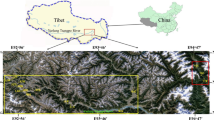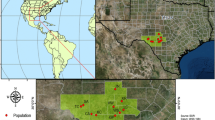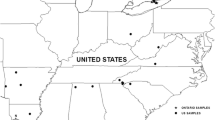Abstract
Understanding the extent and distribution of genetic diversity is crucial for the conservation and management of endangered species. Cupressus chengiana, C. duclouxiana, C. gigantea, and C. funebris are four ecologically and economically important species in China. We investigated their genetic diversity, population structure, and extant effective population size (35 populations, 484 individuals) employing six pairs of nuclear microsatellite markers (selected from 53). Their genetic diversity is moderate among conifers, and genetic differentiation among populations is much lower in C. gigantea than in the other three species; the estimated effective population size was largest for C. chengiana, at 1.70, 2.91, and 3.91 times the estimates for C. duclouxiana, C. funebris, and C. gigantea, respectively. According to Bayesian clustering analysis, the most plausible population subdivision scheme within species is two groups in C. chengiana, three groups in C. duclouxiana, and a single group for both C. funebris and C. gigantea. We propose a conservation strategy for these cypress species.


Similar content being viewed by others
References
Adams RP, Bartel JA, Price RA (2009) A new genus, Hesperocyparis, for the cypresses of the Western Hemisphere (Cupressaceae). Phytologia 91:160–185
Allendorf FA (1986) Genetic drift and loss of alleles versus heterozygosity. Zoo Biol 5:181–190
Avise JC (2000) Phylogeography: the history and formation of species. Harvard University Press, Cambridge, MA
Bagnoli F, Vendramin GG, Buonamici A, Doulis AG, Gonzalez-Martinez SC, La Porta N, Magri D, Raddi P, Sebastiani F, Fineschi S (2009) Is Cupressus sempervirens native in Italy? An answer from genetic and palaeobotanical data. Mol Ecol 18:2276–2286
Beerli P, Felsenstein J (1999) Maximum likelihood estimation of migration rates and population numbers of two populations using a coalescent approach. Genetics 152:763–773
Boys J, Cherry M, Ayanandan SD (2005) Microsatellite analysis reveals genetically distinct populations of red pine (Pinus resinosa, Pinaceae). Am J Bot 92:833–841
Crandall KA, Bininda-Emonds OR, Mace GM, Wayne RK (2000) Considering evolutionary processes in conservation biology. Trends Ecol Evol 15:290–295
Doyle JJ, Doyle JL (1987) A rapid DNA isolation procedure for small quantities of fresh leaf tissue. Phytochem Bull 19:11–15
Du FK, Petit RJ, Liu JQ (2009) More introgression with less gene flow: chloroplast vs. mitochondrial DNA in the Picea asperata complex in China, and comparison with other conifers. Mol Ecol 18:1396–1407
Ellstrand NC, Elam DR (1993) Population genetic consequences of small population size: implications for plant conservation. Ann Rev Ecol Syst 24:217–242
Evanno G, Regnaut S, Goudet J (2005) Detecting the number of clusters of individuals using the software Structure: a simulation study. Mol Ecol 14:2611–2620
Excoffier L, Guillaume L, Schneider S (2006) Arlequin ver. 3.01: An integrated software package for population genetics data analysis. Computational and Molecular Population Genetic Lab, University of Berne
Fahrig L (2003) Effects of habitat fragmentation on biodiversity. Ann Rev Ecol Evol Syst 34:487–515
Farjon A (2005) A monograph of Cupressaceae and Sciadopitys. Royal Botanic Gardens, Kew, UK
Freeland JR, Kirk H, Petersen S (2011) Molecular ecology, 2nd edn. John Wiley & Sons, Chichester, UK
Fu LG, Yu YF, Farjon A (1999) Cupressaceae: 5. Cupressus L. In: Wu ZY, Raven PH (eds) Flora of China, vol 4. Science Press and Missouri Botanical Garden Press, St. Louis, USA, and Beijing, China, pp 65–67
Gapare WJ, Aitken SN, Ritland CE (2005) Genetic diversity of core and peripheral Sitka spruce (Picea sitchensis (Bong.) Carr) populations: implications for conservation of widespread species. Biol Conserv 123:113–123
Garza C, Williamson EG (2001) Detection of reduction in population size using data from microsatellite loci. Mol Ecol 10:305–318
Ge HM, Ren M (2011) DataTrans1.0: A software for microsatellite data processing based on Excel Macro. Fenzi Zhiwu Yuzhong Online 9:1359–1365 (Chinese with English abstract)
Hamilton MB (2009) Population genetics. Wiley-Blackwell, New York
Hao B, Li W, Linchun M, Li Y, Rui Z, Mingxia T, Weikai B (2006) A study of conservation genetics in Cupressus chengiana, an endangered endemic of China, using ISSR markers. Biochem Genet 44:31–45
Hedrick PW (2004) Recent developments in conservation genetics. Forest Ecol Manag 197:3–19
Hubisz MJ, Falush D, Stephens M, Pritchard JK (2009) Inferring weak population structure with the assistance of sample group information. Mol Ecol Resourc 9:1322–1332
Hwang SY, Lin TP, Ma CS, Lin CL, Chung JD, Yang JC (2003) Postglacial population growth of Cunninghamia konishii (Cupressaceae) inferred from phylogeographical and mismatch analysis of chloroplast DNA variation. Mol Ecol 12:2689–2695
IUCN (2012) The IUCN red list of threatened species, version 2012.2. http://www.iucnredlist.org. Accessed 17 Oct 2012
Jia D-R, Liu T-L, Wang L-Y, Zhou D-W, Liu J-Q (2011) Evolutionary history of an alpine shrub Hippophae tibetana (Elaeagnaceae): allopatric divergence and regional expansion. Biol J Linnean Soc 102:37–50
Karron JD (1997) Genetic consequences of different patterns of distribution and abundance. In: Kunin WE, Gaston KJ (eds) The biology of rarity: causes and consequences of rare-common differences. Chapman & Hall Publishers, London, pp 174–189
Kondo T, Tsumura Y, Kawahara T, Okamura M (1998) Paternal inheritance of chloroplast and mitochondrial DNA in interspecific hybrids of Chamaecyparis spp. Breeding Sci 48:177–179
Lande R (1999) Extinction risks from anthropogenic, ecological, and genetic factors. In: Landweber LF, Dobson AP (eds) Genetics and the extinction of species: DNA and the conservation of biodiversity. Princeton University Press, Princeton, NJ, pp 1–22
Lewontin RC (1972) The apportionment of human diversity. Evol Biol 6:381–398
Li Z, Xu H, Zhao G (2013) Isolation and characterization of polymorphic microsatellite loci primers for Cupressus funebris (Cupressaceae). Conserv Genet Resourc 5:307–309
Little DP (2006) Evolution and circumscription of the true cypresses (Cupressaceae: Cupressus). Syst Bot 31:461–480
Little DP, Schwarzbach AE, Adams RP, Hsieh CF (2004) The circumscription and phylogenetic relationships of Callitropsis and the newly described genus Xanthocyparis (Cupressaceae). Am J Bot 91:1872–1881
Mao K, Hao G, Liu J, Adams RP, Milne RI (2010) Diversification and biogeography of Juniperus (Cupressaceae): variable diversification rates and multiple intercontinental dispersals. New Phytol 188:254–272
Mao K, Milne RI, Zhang L, Peng Y, Liu J, Thomas P, Mill RR, Renner SS (2012) Distribution of living Cupressaceae reflects the breakup of Pangea. Proc Natl Acad Sci USA 109:7793–7798
Mogensen HL (1996) The hows and whys of cytoplasmic inheritance in seed plants. Am J Bot 83:383–404
Moritz C (1994) Defining evolutionarily significant units for conservation. Trends Ecol Evol 9:373–375
NAEP (National Administration of Environmental Protection), IBCAS (Institute of Botany, Chinese Academy of Sciences) (1987) List of rare and endangered plants protected in China. Science Press, Beijing
Neale DB, Marshall KA, Sederoff RR (1989) Chloroplast and mitochondrial DNA are paternally inherited in Sequoia sempervirens D. Don Endl. Proc Natl Acad Sci USA 86:9347–9349
Neale DB, Marshall KA, Harry DE (1991) Inheritance of chloroplast and mitochondrial DNA in incense cedar (Calocedrus decurrens). Can J For Res 21:717–720
Nei M (1973) Analysis of gene diversity in subdivided populations. Proc Natl Acad Sci USA 70:3321–3323
O’Connell LM, Ritland K, Thompson SL (2008) Patterns of postglacial colonization by western redcedar (Thuja plicata, Cupressaceae) as revealed by microsatellite markers. Botany 86:194–203
Pandey M, Rajora OP (2012) Genetic diversity and differentiation of core vs. peripheral populations of eastern white cedar, Thuja occidentalis (Cupressaceae). Am J Bot 99:690–699
Petit RJ, Excoffier L (2009) Gene flow and species delimitation. Trends Ecol Evol 24:386–393
Rajora OP, Rahman MH, Buchert GP, Dancik BP (2000) Microsatellite DNA analysis of genetic effects of harvesting in old-growth eastern white pine (Pinus strobus) in Ontario, Canada. Mol Ecol 9:339–348
Rajora OP, Mann IK, Shi Y-Z (2005) Genetic diversity and population structure of boreal white spruce (Picea glauca) in pristine conifer-dominated and mixedwood forest stands. Can J Bot 83:1096–1105
Rosenberg NA (2007) Distruct: a program for the graphical display of population structure. University of Michigan, Ann Arbor, MI
Sakaguchi S, Tsumura Y, Crisp MD, Bowman DMJS, Isagi Y (2012) Genetic evidence for paternal inheritance of the chloroplast in four Australian Callitris species (Cupressaceae). J For Res. doi:10.1007/s10310-012-0384-8
Sebastiani F, Buonamici A, Fineschi S, Racchi ML, Raddi P, Vendramin GG (2005) Novel polymorphic nuclear microsatellites in Cupressus sempervirens L. Mol Ecol Notes 5:393–394
Silba J (1994) The Trans-Pacific relationship of Cupressus in India and North America. J Int Conifer Preserv Soc 1:1–28
Silba J (1998) A monograph of the genus Cupressus L. J Int Conifer Preserv Soc 5:1–100
Tang L-Z, Wang L-Y, Cai Z-Y, Zhang T-Z, Ci H-X, Lin G-H, Su J-P, Liu J-Q (2010) Allopatric divergence and phylogeographic structure of the plateau zokor (Eospalax baileyi), a fossorial rodent endemic to the Qinghai-Tibetan Plateau. J Biogeogr 37:657–668
Wang LY, Abbott RJ, Zheng W, Chen P, Wang YJ, Liu JQ (2009) History and evolution of alpine plants endemic to the Qinghai-Tibetan Plateau: Aconitum gymnandrum (Ranunculaceae). Mol Ecol 18:709–721
Wright S (1965) The interpretation of population structure by F-statistics with special regard to systems of mating. Evolution 19:395–420
Wright S (1978) Variability within and among natural populations. University of Chicago Press, Chicago
Xia T, Meng L, Mao K, Tian B, Miehe G, Liu J (2008) Genetic variation in the Qinghai-Tibetan Plateau endemic and endangered conifer Cupressus gigantea, detected using RAPD and ISSR Markers. Silvae Genetica 57:85–92
Xu HY, Shi DC, Wang J, Xu TT, Wu YX (2008) Isolation and characterization of polymorphic microsatellite markers in Cupressus chengiana S. Y. Hu (Cupressaceae). Conserv Genet 9:1023–1026
Xu T, Abbott RJ, Milne RI, Mao K, Du FK, Wu G, Ciren Z, Miehe G, Liu J (2010) Phylogeography and allopatric divergence of cypress species (Cupressus L.) in the Qinghai-Tibetan Plateau and adjacent regions. BMC Evol Biol 10:194
Yeh FC, Yang R, Boyle T (1999) PopGene: Microsoft Windows-based freeware for population genetic analysis. Release 1.31. University of Alberta, Edmonton
Zheng WJ, Fu LG (1978) Cupressus Linn. In: Editorial Committee of Flora Reipublicae Popularis Sinicae (eds) Flora Republicae Popularis Sinicae Tomus 7: Gymnospermae. Science Press, Beijing, pp 328–336
Zheng W, Wang LY, Meng LH, Liu JQ (2008) Genetic variation in the endangered Anisodus tanguticus (Solanaceae), an alpine perennial endemic to the Qinghai-Tibetan Plateau. Genetica 132:123–129
Acknowledgments
The authors thank Prof. Jianquan Liu for supervising this work. This research was supported by the National Key Project for Basic Research (Grant 2012CB114504), the National High Technology Research and Development Program of China (863 program, Grant 2013AA102605), the open funding (K1002) from Beijing Normal University, and the National Natural Science Foundation of China (Grants 31100488, 31370261, and 41101058).
Author information
Authors and Affiliations
Corresponding author
Additional information
Xu Lu and Haiyan Xu contributed equally to this work.
Rights and permissions
About this article
Cite this article
Lu, X., Xu, H., Li, Z. et al. Genetic Diversity and Conservation Implications of Four Cupressus Species in China as Revealed by Microsatellite Markers. Biochem Genet 52, 181–202 (2014). https://doi.org/10.1007/s10528-013-9638-1
Received:
Accepted:
Published:
Issue Date:
DOI: https://doi.org/10.1007/s10528-013-9638-1




